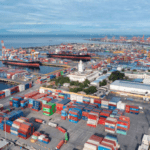- Home
- Trade News
- South Korea semiconductor prod ...

In July, South Korean chipmakers reported their first drop in factory shipments in nearly three years, highlighting weakening demand for semiconductors, which serve as a barometer for the global economy.
Semiconductor shipments fell 22.7 percent year on year after rising 5.1% in June, according to a statement issued by the national statistics office on Wednesday (Aug 31). National inventories remained elevated in July, up 80% year on year and unchanged month on month.
Chip production slowed for the fourth month in a row in July, indicating that key manufacturers such as Samsung Electronics and SK Hynix are adjusting output to reflect cooling demand and mounting stockpiles.
The slowing momentum in South Korean chip sales adds to the global economy’s bleak outlook. Russia’s war on Ukraine, Covid-19 lockdowns in China, and rapid interest-rate increases to combat inflationary pressures are weighing on activity and crimping business profits.
Semiconductors are critical components of a global economy that is becoming increasingly reliant on electronics and online services. During the pandemic, demand for chips increased as many people switched to remote work and education to reduce their risk of infection.
The drop in semiconductor shipments explains why Korea’s technology exports fell in July, the first drop in more than two years. Memory-chip exports fell 13.5 percent that month, despite a 9.4 percent increase in total exports.
Separately, the statistics office reported that Korea’s overall industrial production increased 1.5 percent year on year in July, less than the 2.6 percent predicted by economists.
After Seoul’s reliance on China as a semiconductor export market increased nearly 13-fold over the last two decades, a South Korean trade group has called for a diversification of trading partners in chips.
According to The Korea Herald on Sunday, China will account for 39.7 percent of all South Korean semiconductor exports in 2021, up from 3.2 percent in 2000, citing research published by the Korea Chamber of Commerce and Industry (KCCI), which represents 300 local companies including memory chip giants Samsung Electronics and SK Hynix.
The Seoul-based trade group cited the risks of increasing reliance on China, warning that closing the manufacturing skills gap between the two countries would be disastrous for South Korean industry.
The findings come at a time when Seoul is attempting to strike a delicate balance between maintaining market access in China and joining the US-led Chip4 alliance, which Beijing regards as a plot to marginalise China’s role in semiconductor value chains.
South Korea is expected to attend a preliminary meeting of the Chip4 group, which includes Japan and Taiwan as members, according to Reuters last Thursday.
According to customs data released on Monday, total exports from South Korea to China barely increased in the first 20 days of August. Notably, total shipment volume fell 11.2 percent year on year in the same period.
South Korean firms are major suppliers of memory chips to China’s smartphone manufacturers. Rising Chinese memory chip players such as Yangtze Memory Technologies Corp and ChangXin Memory Technologies are challenging Samsung and SK Hynix, which have invested heavily in building wafer fabs in China over the years.
According to the KCCI report, Chinese demand for South Korean exports has shifted from low-end raw materials and goods to high-end equipment. The precision instruments industry had the highest export dependency rate in 2021, with 42.5 percent of total exports going to China.
In comparison, raw wood materials had the highest dependency rate, accounting for 42.3% of total shipments to China in 2000, followed by leather and shoes.
According to Chinese customs data, the value of all South Korean semiconductor exports to China, including machinery to manufacture silicon boules and wafers, as well as semiconductor and integrated circuit devices and flat panel displays, was $2.59 billion in the first seven months of this year, a 24% decrease from the same period last year.
South Korea recorded a trade deficit with China of US$570 million in July, following deficits of more than US$1 billion in May and US$1.2 billion in June, raising concerns in Seoul about declining Korean export competitiveness with China. Prior to May, South Korea’s last trade deficit with China was in 1994.
To find out more about accessing a new market, you can check out this article which teaches you how to use Trade Data Pro to access Turkey markets: https://blog.tradedata.pro/why-you-should-be-importing-from-turkey-in-2022/
The most trustable and reliable source for Trade Data.
Trade Data Pro is proudly made in Singapore. Singapore has been one of the world’s most politically stable countries, with an open and trade-driven economy. Trade Data Pro is presented by CIC, a government-linked company in Singapore CIC is a Join Venture of Zall Smartcom, SGX and GeTS.)
Since the launch of Trade Data Pro in 2018, Trade Data Pro has received overwhelmingly positive remarks from market. This is because Trade Data Pro has wide coverage, low cost, and fast response. There are many leading companies from different industries that have subscribed to Trade Data Pro .
Trade Data Pro was awarded with Singapore Quality Class in 2020 and Stevie Award Gold in 2021. Businesses need information to reveal trends, identify market opportunities, track competitors buyers and suppliers, and better understand supply chain potential.
Finding these critical data has traditionally been challenging. But this information do exist, but as part of government import and export filing requirement. The detailed shipment information which are within these filings constructions the core of the global trade.
Trade Data Pro has gathered and packaged these information as business intelligence. Our solution helps companies understand the flow of goods across borders and features the world’s largest searchable trade database.
We do the heavy lifting for you by reviewing, standardising, and cleaning data, then delivering in an intuitive format.
Business China Consumer Goods Economy Export factory Global Import India International Trade manufacturing Semicounductor South Korea Trade
Recent Posts
Archives
- May 2025
- April 2025
- March 2025
- February 2025
- January 2025
- December 2024
- November 2024
- April 2024
- March 2024
- January 2024
- December 2023
- November 2023
- October 2023
- September 2023
- August 2023
- July 2023
- June 2023
- May 2023
- April 2023
- March 2023
- February 2023
- January 2023
- December 2022
- November 2022
- October 2022
- September 2022
- August 2022
- July 2022
- June 2022
- May 2022
- April 2022
- March 2022
- February 2022
- January 2021
Categories
Recent Post
Forecasting a Brighter Outlook for Chile Imports
- May 30, 2025
- 8 min read
Italy Imports More Gas, Less Textiles and
- May 2, 2025
- 9 min read
Strategy-Driven Upward Trends for Exports of the
- May 2, 2025
- 13 min read
All Tags
Agriculture Automotive Brazil Business Business Opportunities Buyers China Coffee Commodities Crops Ecommerce Economic Economy Electronics Energy Environmental Europe Export Exports Future Garments Global Import India Industries International Trade Leads Leads Generation manufacturing Markets Opportunities Pharmaceuticals Prices Rice Russia Supplier Textiles Trade Trade Data Trade Data Pro Turkey Ukraine United States Vietnam Worldwide








